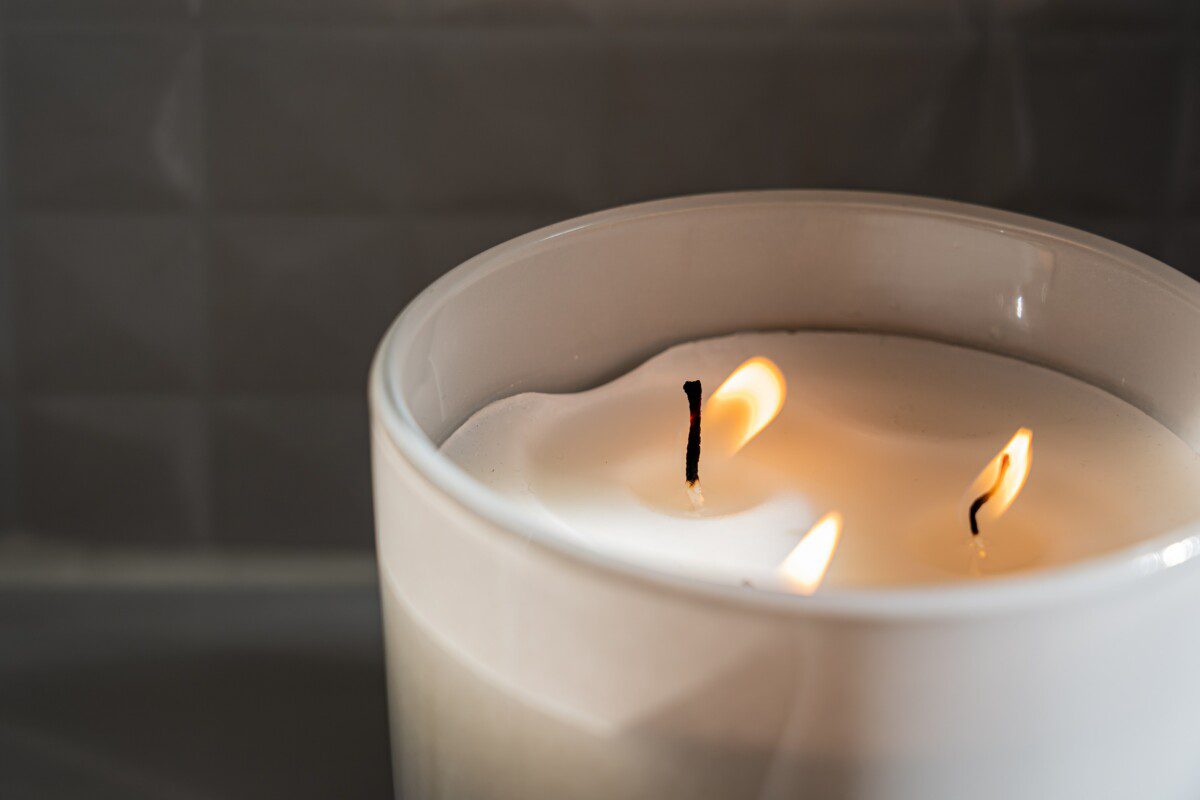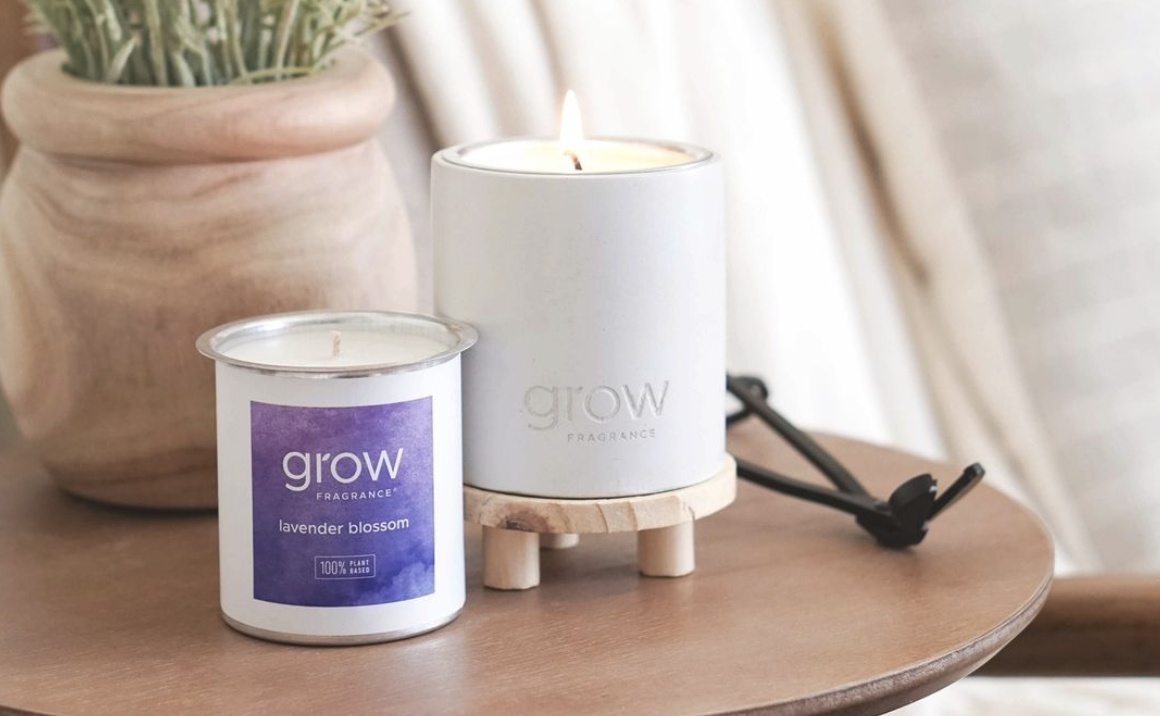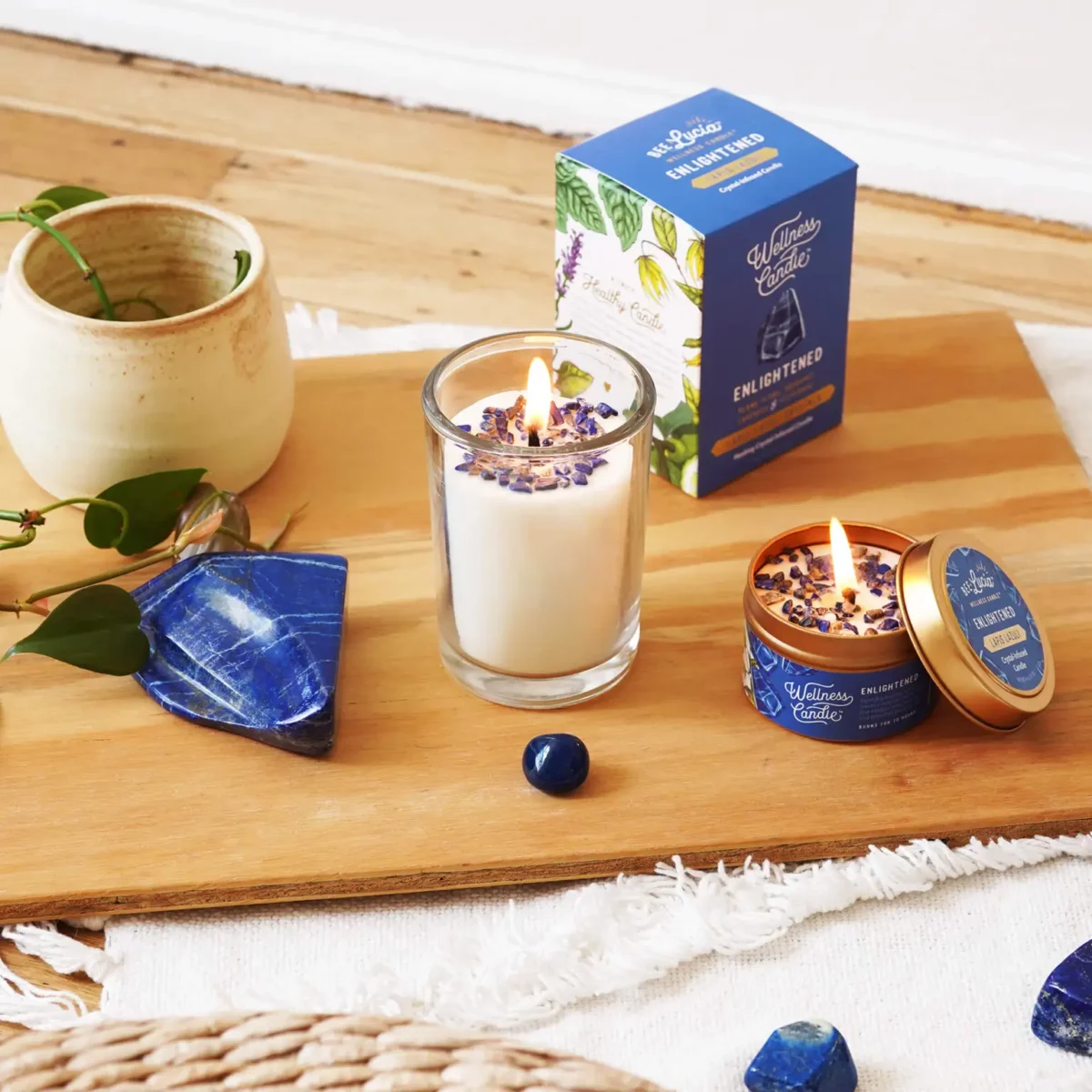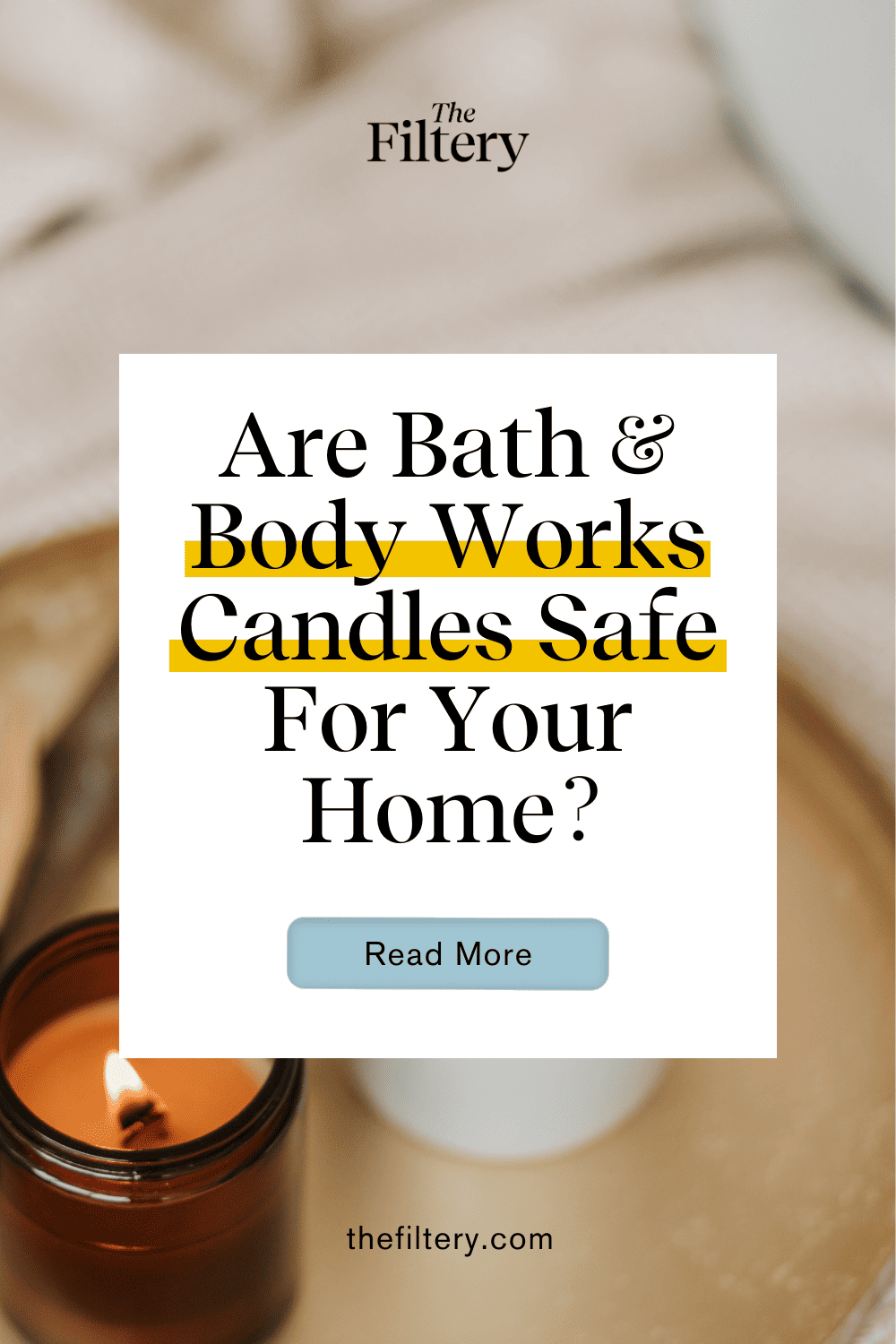It would be hard to find a household in the United States that doesn’t have (or has never had) a Bath and Body Works body wash, lotion, or scented candle.
Bath and Body Works candles in particular make popular gifts and are well known for providing a warm ambiance and a beautiful fragrance throughout the home. But it seems there may be a sinister presence lurking in the shadows… or should I say in the air?
When burning Bath & Body Works/White Barn candles in the house, there are chemicals emitted that can be potentially hazardous to one’s health, especially for children, pets, and others who are more sensitive or vulnerable to these chemicals.
Let’s delve a little deeper to answer the question: are Bath and Body Works candles toxic? Can they be bad for you, your kids, or your pets?
IN A NUTSHELL: Bath & Body Works Candles Contain Potentially Toxic Ingredients
- Bath & Body Works and White Barn Candle Co. are owned by the same company. Their ingredients and manufacturing processes are very similar.
- Bath & Body Works/White Barn candles are made primarily from hydrogenated soy wax and paraffin wax. When burned, they release particulate matter and VOCs, which include toxic BTEX chemicals.
- Bath & Body Works is not transparent about what ingredients are included in their candle “fragrances.” There are over 3,500 different chemicals that could be included under this umbrella, including hormone disruptors like phthalates.
- In addition to paraffin wax and mystery fragrances, Bath & Body Works and White Barn candles also contain other additives like dyes and stabilizers, some of which are linked to health concerns.
- The indoor air pollution created by most conventional candles is not great for anyone’s health but some populations are more vulnerable to the short- and long-term effects of scented candles.
- While many of the environmental toxins around us are out of our control, avoiding candles (or choosing to burn cleaner ones) is one thing consumers can actually do to reduce their exposure to endocrine disrupting chemicals, carcinogens, and allergens.
Table of Contents: Why Bath & Body Works/White Barn Candles Are Toxic
- IN A NUTSHELL: Bath & Body Works Candles Contain Potentially Toxic Ingredients
- The Bath & Body Works Backstory
- White Barn vs. Bath & Body Works: Are They The Same?
- What Are Bath and Body Works Candles Made Of?
- #1. The Wax
- What Is a Paraffin Candle? Why Is It A Problem?
- What Are Vegetable Wax Candles Made Out Of? Are They Toxic?
- #2. The Fragrance
- Are There Phthalates In My Bath and Body Works Candle & Should I Be Concerned?
- #3. Other Additives
- #4. The Wick
- Bath & Body Works Candles Are Bad For Indoor Air Quality
- Why Do Bath And Body Works Candles Turn Black?
- Are Bath & Body Works Candles Safe To Breathe?
- Symptoms To Look For When Burning Candles:
- Are Burning Candles Bad For Dogs and Cats?
- Healthier Candle Alternatives
- Ways To Make Burning Candles Safer In Your Home:
- TL;DR: Are Bath And Body Works and White Barn Candles Toxic?
First, a Quick Note:
We recognize that Bath & Body Works is one of those brands to which many people feel loyal. Maybe you have been using and loving Bath & Body Works products for years, and you might find comfort and joy in the scents they offer and the memories associated with them. Our goal is not to take away those joys, but simply to provide you with some information so that you can decide what’s best for yourself and your family. These days, so many people are dealing with things like asthma & allergies, autoimmune conditions, chemical sensitivities, cancer, and other chronic illnesses, which can be caused or exacerbated by the ingredients in our personal care and home products. We believe consumers deserve to know what’s actually in the products they buy and to be empowered to avoid them if they choose.
The Bath & Body Works Backstory
First, a quick history about the brand…
Bath and Body Works opened its doors first as a bath and beauty line in Express clothing stores in the early 1990s and shortly after with its own storefronts.
Their original marketing would definitely be considered greenwashing today. The whole look, feel, and experience of BBW was to make you feel like they were a “nature-inspired” brand, the embodiment of country goodness, solid values, and products that are “natural” and “non-toxic” when based on their ingredient list, that is truly not the case.
Let’s dive into it.
White Barn vs. Bath & Body Works: Are They The Same?
White Barn and Body & Body Works are owned by the same company so yes: White Barn belongs to Bath & Body Works. White Barn’s candles tend to have more of a classic and neutral aesthetic to them, but when it comes to the wax, fragrances, and lack of transparency, it’s all essentially the same.
Since they contain the same ingredients, White Barn can be considered just as toxic as Bath & Body Works.
What Are Bath and Body Works Candles Made Of?
What kinds of candles does Bath & Body works sell, and what are they actually made of?
In order to answer the question “Are Bath and Body Works candles bad for you?” we have to dive into the ingredients.
There are four main components of Bath & Body Works candles:
- The Wax
- The Fragrance
- Other Additives
- The Wick
#1. The Wax
There are two main types of wax Bath & Body Works uses for their candles:
- Vegetable wax (which includes soy)
- Paraffin wax
The brand says their “Signature Collection Candles” are paraffin-free and contain a blend of vegetable and soy wax but I can’t actually find a paraffin-free collection on the website. As I’ll get into below, paraffin wax is not something you want to be burning in your home.
The website states: “Our candles are made with a soy blend wax.” At first, that seems like a good thing (soy candle are pretty good, right?!). However, if you actually dive deeper into the ingredients in the candles, you’ll find that most of them contain:
- Hydrogenated Soybean Oil
- Paraffin
- Hydrogenated Palm Oil
For the sake of being thorough, I opened a chat directly on Bath and Body Works’ website, and I requested the Customer Service Representative to direct me to the candles without paraffin. Unfortunately, they were not able to point us to any paraffin-free candles and we have not received any follow-up information from them since.
I perused over 40 ingredient descriptions throughout writing this article, and all of them contained paraffin. (If you ever find any BBW paraffin-free candles, please let us know!)
For now, anyway, it appears that Bath & Body Works does not actually carry any paraffin-free candles.
What Is a Paraffin Candle? Why Is It A Problem?
Paraffin is a petroleum-based wax. It is made from refined slack wax, which is the direct by-product of petroleum oil refinement (or shale oil or coal). This slack wax contains high oil levels, and once it is thoroughly refined, the oil content is lower and becomes paraffin wax.
Almost all petroleum-derived products come with some sort of health risk, especially when they build up in the body over a long period of time. When paraffin wax candles in particular are burned, they release toxic BTEX chemicals:
- Benzene (a carcinogen)
- Toluene (a reproductive toxin)
- Ethylbenzene (also a carcinogen)
- And xylene (an irritant)
Together, these chemicals can also cause things like headaches, nausea, respiratory problems, and problems with neurological and immune function.
Burning paraffin candles is basically like burning fossil fuels in your home… it’s not good for your body or the environment.
To make the rest of the candle smell good and look pretty, the paraffin wax is mixed with synthetic fragrance, synthetic glosses, chemical fixatives, colorants, and a wick (which may be made from wire, cotton, and/or wood).
What Are Vegetable Wax Candles Made Out Of? Are They Toxic?
As noted, most of Bath & Body Works and White Barn candles are made out of a combination of “vegetable” wax (which can include soy and palm) and paraffin wax.
A “vegetable” wax candle is actually not made from vegetables (it’s a little misleading), but rather other plant oils such as soy, coconut, palm, rapeseed, and sunflower, to name a few.
Simply put, the oils from these plants are treated with hydrogen gas so that the oils become saturated fatty acids with a higher melting point. When combined with a few other ingredients, these oils then become the “vegetable” wax blend that’s used in many conventional candles.
The “vegetable” part of Bath & Body Works’ wax blends are mostly hydrogenated soybean oil and hydrogenated palm oil.
Though these types of wax are generally considered healthier than paraffin in terms of what’s emitted while they’re being burned, when added with a bunch of ingredients like “fragrance”, wick material, and more they become more toxic. Additionally, palm and soybean oil/wax are not the most sustainable options, as the overuse of these materials in beauty, home, and personal care products contributes to deforestation and animal displacement (specifically Orangutans).
#2. The Fragrance
The problem here is that the laws around the labeling of “fragrance” ingredients are different from what is required for all other ingredients. In what is known as the “fragrance loophole,” companies are legally allowed to withhold the actual ingredients in “fragrance” because they’re protected as “industry secrets.”
The label of “fragrance” (or “parfum”) is really an umbrella term. Even though it’s listed as a single entity on the product label, it can be comprised of so many things.
There are over 3,500 chemicals that can be generically labeled “fragrance,” and that one word can consist of any number of them at one time.
This is one reason candles can cause some people headaches and even migranes. Some of those 3,500+ chemicals are natural and others are synthetic. Some are perfectly safe while others are known hormone disruptors, allergens, and carcinogens.
They include things like:
- phthalates (more on that below)
- petroleum distillates
- limonene and other potentially sensitizing essential oils
- and more.
When one word can represent several thousand ingredients, consumers are denied the opportunity to make an informed decision. How can you know if what you are bringing into your home may hurt you, your family, or your pets if you can’t actually figure out what’s in the product?
Plus, to make matters worse, in addition to some of these VOCs being volatile on their own, they can also react to the ozone in the air in the confined spaces in our house and create a secondary pollutant: formaldehyde.
Deep dive into the “fragrance loophole” here.
Are There Phthalates In My Bath and Body Works Candle & Should I Be Concerned?
Phthalates are one of the chemical categories that fall under the “fragrance” label, meaning we can’t know for sure whether or not Bath & Body Works and/or White Barn candles contain them.
Phthalates (pronounced THAL-ates) are a class of chemicals that are used in many different consumer products. In candles, phthalates help fragrance bond to the wax and allow the scent to linger.
According to EWG research in 2002, over 70% of products with “fragrance” on the label have phthalates hidden in the product.
DEP (Diethyl Phthalate) and DBP (Dibutyl Phthalate) are solvents that help to extend the scent(s) in the fragrance oil and reduce brittleness, respectively. However, these chemicals are toxic.
- Both are known endocrine disrupters
- They are linked to development and reproductive toxicity
- They have even been linked to cancer.
Those who would prefer to play it safe may want to avoid candles, personal care products, air fresheners, and cleaning products that do not transparently list all of their and/or are not explicitly “phthalate-free.”
(As of early 2024, it appears that neither Bath & Body Works nor White Barn candles are explicitly phthalate-free.)
#3. Other Additives
If you start digging through the ingredient lists on the candles, you’ll not only find paraffin wax and “fragrance,” but a lot of other synthetic additives such as:
- BHT (which is linked to various health concerns)
- Other allergens (like linalool and hexyl cinnamal)
- And dyes
Of course, not all synthetic additives are toxic chemicals. But these longer (and hard to find) ingredient lists just make it more difficult for consumers to know what’s in their products.
#4. The Wick
Good news here! Bath & Body Works does not use lead in their candle wicks.
In 2003, The U.S. Consumer Product Safety Commission (CPSC) banned the manufacture and sale of lead core wicks and candles with lead-cored wicks.
The ban is also supposed to cover manufacturing and importing candles with lead-cored wicks; however, several imports from China and Mexico with candle wicks still contain lead. So to be safe, always be sure to read the label and know where your candle was manufactured.
Related:
Home
Are Bath & Body Works Wallflowers Safe? Or Toxic to Humans, Dogs & Cats?
Nearly everything in a Bath & Body Works store smells great, there are some things to keep in mind when shopping their products. Are Bath and Body Works Wallflowers toxic?
Bath & Body Works Candles Are Bad For Indoor Air Quality
When candles are lit, they begin to release particulate matter (PM), which contains volatile organic compounds (VOCs) and polycyclic aromatic hydrocarbons (PAHs). These particulates contribute to indoor air pollution and can potentially contribute to:
Since paraffin candles are petroleum products, this form of indoor pollution is consistent with fuel exhaust and cigarette smoke. One could certainly argue that the amount of PM released from a paraffin wax candle is going to be much smaller than the amount released from, say, a diesel truck. However, paraffin candles are most often burned in closer quarters and without adequate air circulation.
Volatile organic compounds are potentially harmful chemicals (depending on the specific one) that vaporize at room temperature, specifically when paraffin wax candles are burned.
- These gasses in the air can cause headaches
- Irritation
- And allergic reactions
Not only are they in candles, but they’re also present in lots of other products in our home, including furniture, paint, and carpeting.
(Conscious consumers will also want to consider the cumulative impact of breathing in all of the air pollution around them. Even if the amount of PM from one candle is small, we are also inhaling PM from a lot of other sources throughout our days. While we have limited control over most of those sourced, candles are one thing we are actually able to make decisions about.)
Why Do Bath And Body Works Candles Turn Black?
The black stuff coming from your candles is good ol’ fashioned soot (like the chimney kind). Sometimes the soot is contained in the jar, and other times it can spread to walls and furniture. Either way, it’s no good.
Black soot particles can be ultrafine—the size and makeup similar to diesel exhaust. They can penetrate deeply into the lungs and be absorbed into the bloodstream. These particulates are associated with allergies and asthma, but they can also contribute to other respiratory diseases, heart attacks, and even cancer.
But why is your Bath & Body Works or White Barn Candle producing soot?
The soot itself is a chemical reaction that happens when the flame gets too much or too little fuel (candle wax) or air. This alters the reaction and lets unburned carbon particles (soot) escape the flame before it’s able to reach a clean burn.
A lot of times we think that a strong fragrance in a candle means it’s high quality. But as we’ve learned, “fragrance” is a complicated word. According to the EPA it is well established that waxes with more fragrances produce more soot — and that’s exactly what BBW candles are known for, the fragrance.
Are Bath & Body Works Candles Safe To Breathe?
The majority of migraine sufferers will likely tell you that heavy scents or perfumes can trigger an attack. Some people can’t even go down a laundry detergent aisle in a supermarket or step into a Bath and Body Works store because they are sensitive to fragrances.
Those most susceptible to the effects of burning candles, fragrances and VOCs are:
- asthmatics
- elderly people
- children
- immunocompromised individuals
- and anyone sensitive to pollutants, chemicals, or fragrances.
The EWG warns asthma sufferers: “…fragrance formulas are considered to be among the top 5 known allergens, and can trigger asthma attacks.”(And let’s not forget our four-legged family members).
Related:
Home
5 Safest Non-Toxic Plug-In Air Fresheners in 2024
If you’re doing an overhaul on your household products, a good place to start is with non-toxic plug-in air fresheners. Making the switch is pretty darn easy in 2024!
Symptoms To Look For When Burning Candles:
Burning Bath and Body Works’ and White Barn’s highly scented candles can trigger allergic reactions and acute symptoms. These can include:
- headaches/migraines
- sore throat
- itchy and watery eyes
- blocked nasal passages
- hives
- itchy skin
- asthma-like conditions
If you have respiratory allergies or asthma and are sensitive to these fragrances, you can experience more severe reactions.
Of course, these are only the short-term and immediate potential effects of candles; this doesn’t take into consideration the longterm effects of inhaling endocrine disrupting chemicals and carcinogens, as discussed above.
Are Burning Candles Bad For Dogs and Cats?
Burning toxic paraffin candles can have several different effects on your pets. Many fragrance oils are also irritating and harmful to dogs, such as:
- Cinnamon
- Citrus (d-limonene)
- Peppermint
- Tea tree
- and Pine to name a few.
You also may have to consider that the scent may be appealing to your dog or cat, and it could try to eat the candle (which would be bad).
In addition to the harm of inhaling paraffin wax, cats can be sensitive to new scents, especially near their food or litter box. Some essential oils can be toxic for cats when ingested or with skin contact. If you have a curious companion, be on the lookout for:
- Bitter almond
- Wintergreen
- Citrus
- Cinnamon
- Ylang-ylang
- And tea tree (melaleuca) oil
Just keep in mind when you light a candle, if your pet begins sneezing, itching, rubbing its face on the floor or furniture, scratching its face or muzzle, shaking its head, or acting crazier than usual, it’s time to put the candle out. Try to ventilate the area right away and don’t be afraid to call your vet if you’re worried or unsure.
Healthier Candle Alternatives
Even if you buy a White Barn or Bath & Body Works unscented candle that doesn’t contain harmful fragrance chemicals, it’s still likely to be paraffin-based. The good news is that there are plenty of safer alternatives to use instead of Bath & Body Works candles.
The three most commonly used types of wax that are more eco-friendly and non-toxic than paraffin are soy (without the extra paraffin, palm wax, etc.), coconut, and beeswax. Check out our ultimate guide to non-toxic candles for more candle alternatives.
Home
The Ultimate Guide to Organic & Non-Toxic Candles
Learn about what’s actually in conventional scented candles and what to look for in organic, non-toxic candles instead!
Safe: Soy Wax Candles
If you’d like to give soy candles a try, check out our 7 recommendations for the best non-toxic soy candles.
Home
The 7 Best Brands for Non-Toxic, Natural Soy Candles
Soy candles have their downsides, but they’re a much better alternative to conventional paraffin wax candles, and in this article, you’ll learn why. Then we’ll give you the best brands for non-toxic soy candles (and we considered a LOT of brands!
Safer: Coconut Wax Candles
Coconut wax has its pros and cons, which you can read more about in our guide to 5 non-toxic coconut candles
Home
Pros & Cons of Coconut Wax Candles (+ The Best Non-Toxic Brands)
In this article, you’ll learn about the pros and cons of coconut wax candles along with the best non-toxic brands.
Safer: Beeswax Candles
If you’d like to go with beeswax candles, here are our 9 picks for the best non-toxic and sustainable brands.
Home
The Best Non-Toxic Beeswax Candles (Scented & Unscented)
When making the switch away from paraffin wax, beeswax candles are one of the BEST natural and non-toxic alternatives you’ll find. Here’s why (+ our recommended brands).
Ways To Make Burning Candles Safer In Your Home:
If you just aren’t convinced yet and want to hold on to your favorite Bath and Body Works candle even though it could be toxic, here are a couple of tips to help reduce VOCs and burn your candles more cleanly:
- Always cut your wick to ⅛ inch before you use it (each time)
- Remove any “mushroom” wick ends and do not allow them to fall into the wax.
- Burn candles in open spaces with good ventilation (but not drafty).
- Do not put a candle in a high-traffic area.
- Make sure no fans or A/C vents are affecting the flame.
- Keep the candle out of the reach of little ones.
- Don’t place a candle where a four-legged furniture fumble could occur.
- Instead of blowing it out, use a candle snuffer or lid to extinguish. (Or take it outside to blow out, but don’t blow directly into candle)
- Use a high-quality air purifier.
TL;DR: Are Bath And Body Works and White Barn Candles Toxic?
Yes, I would consider Bath & Body Works and White Barn candles toxic and not safe for three main reasons:
- They are made primarily of paraffin wax.
- They contain other petroleum-based additives.
- BBW is not transparent about what’s actually in their fragrances.
On a daily basis, we are exposed to a toxic load in our homes from off-gassing furniture, cleaners, perfumes, radiation, and more. But we don’t have to be at the mercy of fancy advertising and seductive scents. Any time you can find a way to reduce harmful exposures with easy “use this, not that” options, it just makes sense! I hope this helps you make an informed decision for you and your family!












Does burning the candle pose the same risk as putting it on a candle warmer?
Hi Shelby,
Although I don’t believe I’ve come across any research that looks at that specific question, my educated guess would be that using a candle/wax warmer would not be QUITE as bad as burning it. You’d still be releasing things into the air, but my guess would that there would be LESS particulate matter and PAHs because you’re not actually burning something.
Why is all this information available but yet the store is still able to sell these products with no warning … like the surgeon general on cigarettes?
Hey Fran,
The way our laws work when it comes to environmental toxins is really unfortunate… Most people think companies have to prove their products and ingredients are safe before they hit the market, but they don’t. Companies self-regulate, which basically means they make sure their products won’t cause any severe acute reactions (like skin rash, for example), but that’s it. There are a lot of loopholes, unclear language, and outdated info in the Toxic Substances Control Act. There are over 86K chemicals registered for use in the US, but only about 200 of those have actually been tested for safety. And of course, there is a LOT of corporate influence over what gets regulated and what doesn’t… Even to get the Surgeon’s General warning on cigarettes took YEARS of fighting from scientists and citizens because the powerful tobacco industry kept insisting that cigarettes were safe (even when they knew they weren’t). Today’s big chemical corporations are following the same playbook used by the tobacco industry back then.
Wow! I have been an Avid bath and bodywork’s fan buying tons of candles. But after contracting AML last year( acute myeloid luekemia). I’ve become more concerned about products we use in our home. I’m not saying bath and bodywork’s candles gave me cancer am just trying to make my life and my family’s life bit safer without using toxic products and even foods in our lives. This article has been very eye opening and informative. Thank you so much.
Sincerely Marisol Busch
If you want a good candle it will have Paraffin in it. No one had a problem with it until Soy companies started pushing their new invented wax.Even Soy candles have Paraffin otherwise they would melt too fast. Your parents, their parents and so on grew up with Paraffin candles and didn’t get ill. There is no scientific study anywhere that proves anyone got cancer from a Paraffin candle. The brainwashing about Paraffin being so bad is crazy. The air you breath outside is worse than a Paraffin candle. The fumes you breath from bathroom cleaners, the fumes you breath while filling your gas tank and so on are worse. Think about that and enjoy your candle.
Hi EF,
Thanks for the comment! While some “soy” candles do contain paraffin and other kinds of waxes (which is addressed in the concern about “wax blends”), other companies do use pure soy or soy + coconut/beeswax wax. (Some of our other candle articles list some of the candle brands that are committed to using paraffin-free wax and listing their ingredients transparently.)
Second, we agree that both indoor and outdoor air pollution can be very concerning… Which is why many people are choosing to burn healthier candles because it’s one small thing they can actually control to decrease their exposure to things like BTEX chemicals. As you mentioned, choosing non-toxic bathroom cleaners and other household products is another way you can help decrease your indoor air pollution. 🙂
Thank you so much for this article! I was burning a White Barn candle for the first time tonight and couldn’t understand why I started coughing and couldn’t stop (I’ve burned many other candles with no respiratory problems). Of course, now that I blew it out, the coughing stopped. Your article taught me a lot about paraffin, something that I never knew was linked to petroleum. But I’m not surprised given my reaction to this particular candle! Thanks again
Does it mean that all Yankee candles are toxic too since it is made from paraffin wax ? I noticed that BBW candles often received a lot of bad reviews on their safety whereas Yankee candles for their lack of scent.
Hi there,
Unfortunately, yes, Yankee Candles have a lot of the same issues. Check out this article for more: https://thefiltery.com/are-yankee-candles-toxic-or-safe/
Your article is very misleading. I stopped reading when you lied and said they don’t have the ingredients, because I have $5000 worth of product that all have an ingredient label.
Hi Amane,
As the article explains, even though SOME of the ingredients may be listed, anytime you see the word “fragrance” on the label, that means there are extra ingredients in the product that are not legally required to be listed. There are currently about 4,000 different ingredients allowed to be listed under that one word, “fragrance” (or “parfum”). Some of these ingredients are perfectly harmless, while others include allergens, endocrine disruptors, and carcinogens. That’s for personal care products like body sprays. When it comes to candles, there is even less regulation. As the article talks about, companies can call pretty much anything a “wax blend” without actually saying what specifically is in that blend. So essentially, even though SOME ingredients are listed on these products, there is incomplete info that lacks transparency.
Our goal is not to keep consumers from the products they love, so if you enjoy Bath & Body Works – go for it! But we believe consumers should be informed about what’s actually in the products they buy and use. With the increase in things like chronic illness, skin conditions, and chemical sensitivities, we want to be here to help consumers educate themselves and figure out what types of products are best for them, their families, and their environments.
I hope that helps!
Would it help if I made the candle into a wax melt? I have some old candles I don’t want to waste but I also don’t want to burn them knowing how harmful it is.
I definitely get the waste issue! It does appear that melting the wax is less bad than burning it as a candle. If no one in your home has chronic illness or other types of sensitivities, I would say you could go ahead and melt the rest of your conventional candles in a wax melt if you want to reduce waste. 🙂
I appreciate that you explained when these candles are burned, synthetic scents and colors emit a high number of VOCs, including phthalates, limonene, petroleum distillates, alcohol, and esters, many of which are designated as harmful or poisonous. My best friend is looking for some info, this should help him. I appreciate that you helped me learn more about candles.
Can you provide any studies to back up your claims that certain ingredients are toxic and can cause health issues?
Hi Lily,
You can click through the hyperlinked text throughout the article to find studies and resources from the CDC, EPA, independent research organizations, and more!